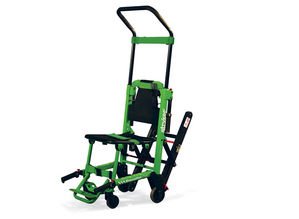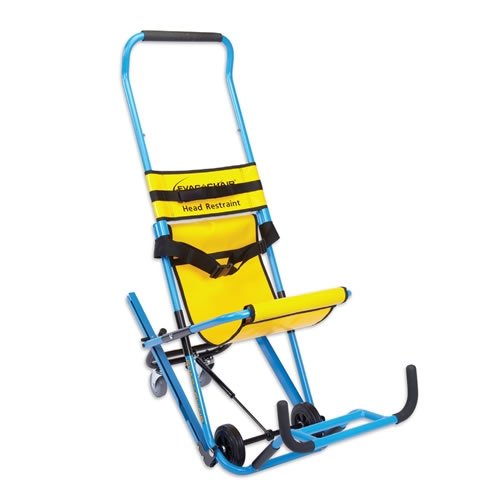Evacuation Chairs
Everything you need to know about evacuation chairs
The importance of businesses having access to an evacuation chair, and the right training to be able to use it, cannot be underestimated. The Regulatory Reform (Fire Safety) Order 2005 states that business owners have a duty, by law, to ensure the safety of all people who are on their premises.
Emergencies can happen anywhere, at any time, and business owners need to make sure that they are always prepared to evacuate everyone out of their building safely and quickly. With SHP‘s focus on fire safety this month, we thought we’d revisit a previous article which talks about the importance of evacuation chairs, what they are and how they work…
What are evacuation chairs?
Evacuation chairs provide mobility impaired people with a safe and comfortable way to evacuate a building in the event of an emergency, such as a fire.
The chairs can help a variety of different people who may be in your building. A person may be unable to be evacuated without assistance due to disability, an injury, mental health, pregnancy or other medical conditions. Evacuation chairs allow them to leave a building quickly and safely during an emergency.
Evacuation chairs are also known as disabled evacuation chairs, stairway evacuation chairs, fire evacuation chairs, or evac chairs.

How do they work?
The chairs are made out of materials that are lightweight but strong. While going down the stairs, the tracks attached to the chair create friction which slows down the descent and allows for a controlled journey. Once a person reaches ground level, the chair can then be used as a wheelchair to ensure the evacuee can get to safety. When not in use, evacuation chairs simply fold flat and are stored neatly on the wall.
It’s important to ensure that you have people in your building trained in evacuation chair handling. This is so anyone assisting the evacuee is both confident and capable, and helps get everyone to safety in a quick and efficient way.
Do I need an evacuation chair?
Under current fire safety legislation it states that it is the responsibility of the person in charge of a building to provide a fire safety risk assessment. This assessment needs to include an emergency evacuation plan for all people likely to be in the premises, including disabled people.
If your building is open to the public, you may have a wide range of visitors or customers.
In the UK today, 7.6 million people between the ages of 16 and 64 have some form of disability, which equates to approximately 1 in 8 people. There is a high chance that one of your visitors, or employees, will need assistance from an evacuation chair if an emergency is to occur.

Although neither the Disability Discrimination Act 1995 or the Equality Act 2010 mentions evacuation chairs specifically, if a business owner or service supplier does not take action to provide a safe evacuation plan for disabled people or limits access to parts of the building, this could be viewed as discrimination.
Don’t take the risk
Evacuation chairs play a vital role in the fire safety and evacuation plan of a building. It’s so important to ensure that all employers, customers and visitors can safely leave a building in the event of an emergency. Evacuation chairs can save lives, and as a business owner, you have a responsibility to ensure that you are fully prepared for an emergency.
Rosa Mitchell is a writer for imperative training, the largest independent first aid training provider in the UK.
Everything you need to know about evacuation chairs
With SHP‘s focus on fire safety this month, we thought we’d revisit a previous article which talks about the importance of evacuation chairs, what they are and how they work…
Safety & Health Practitioner
SHP - Health and Safety News, Legislation, PPE, CPD and Resources Related Topics
The planning, conduct and evaluation of emergency exercises in rail transport
Are you evacuation ready?
2023 BUDGET: Focus on disability benefits and workplace wellbeing



I am not a big fan of these chairs because they are difficult-to-use. I personally believe that evacuation mattresses are more effective in case of evacuation. They are super simple to use and less expensive.
Have you spoken to the people who sit in the chairs (or lie on the mattress) to get their perspective about how dignified the process is for them?
I agree with you about the mattresses. I have changed over to those, they are much easier to use. I asked a couple of our less able guests their opinion and being lower to the ground made them feel safer than feeling they would ’tilt’ as they would in a chair
This is an interesting discussion. I believe both products are suitable solutions in differing environments. The mattresses will need less training however the manual handling implications mean that dependant on the weight of the patient (and the strength Of the operators) you could need up to 6 people to evacuate 1 patient. The strength of the chairs is that they are single person operated making our evacuation plan easier. The transfer is also easier chair to chair.
This article actually sums up almost everything we’ve discussed when I was taking evac chair training from a local provider a few months back. It’s great that you’ve mentioned what these equipment are and how do they work. This is quite crucial as most people think it’s simple to use evacuation chairs. And just like what you’ve said, it’s important to have people in the building who are properly trained in handling evacuation chairs. Anyway, do you also have a guide on how to buy evacuation chairs? We’re planning to buy a couple of new ones for our office, so… Read more »
Who should pay for the training in local authorities premises where there are evacuation chairs? Each department that has disabled employees or the authority as part as building management? What happens where you work?